The Best 10 Alternatives to Hexnode UEM (+ Pricing & Reviews)
Twingate Team
•
Jul 27, 2024

Hexnode UEM is a platform designed to manage various devices and operating systems within an organization, offering a unified solution for endpoint management. While it provides comprehensive features, it might not be the choice for everyone. This article explores the benefits of using Twingate for secure access to private resources.
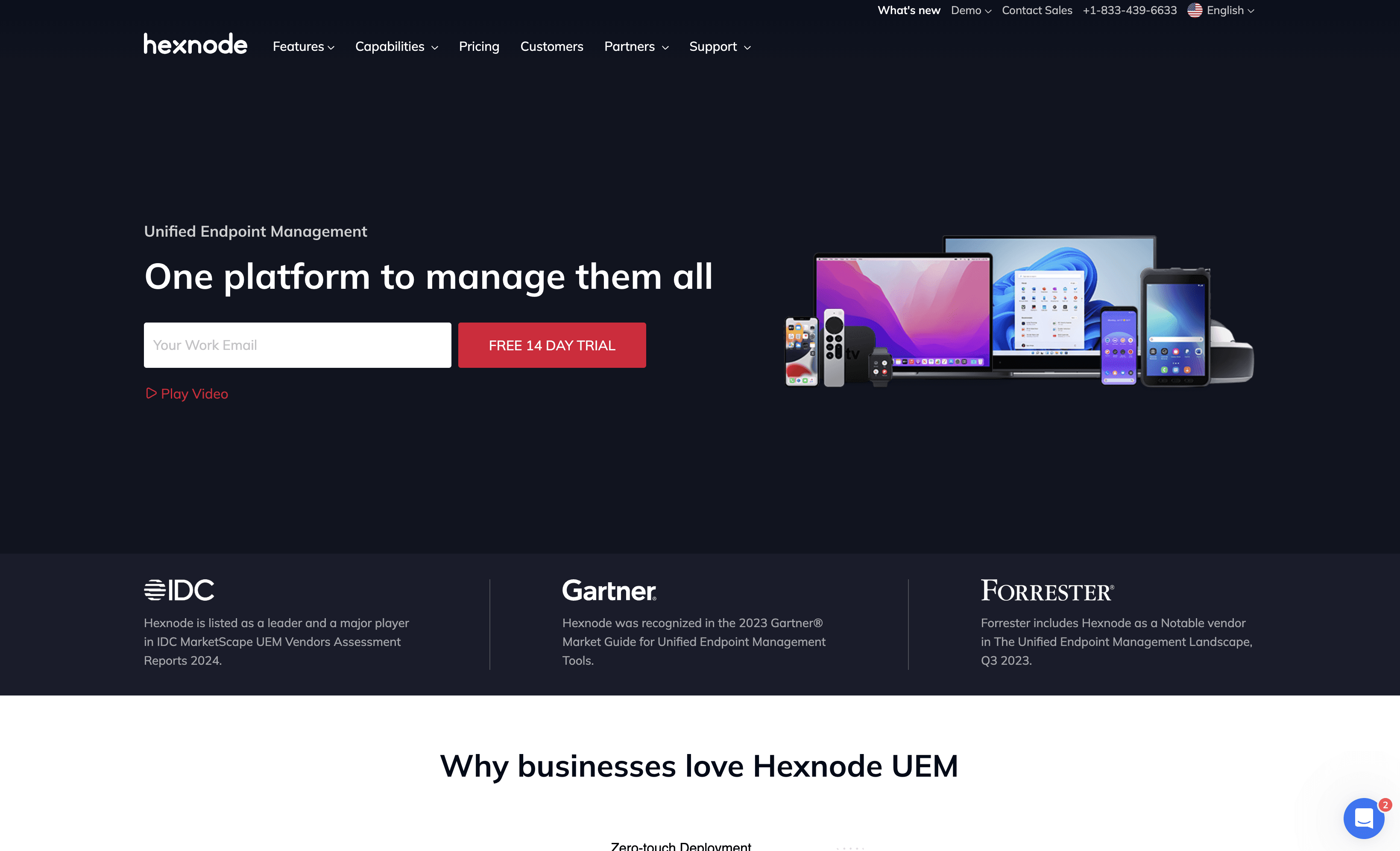
10 Alternatives to Hexnode UEM
1. WatchGuard Endpoint Security

WatchGuard Endpoint Security is a comprehensive solution designed to combat advanced cyber threats. It integrates various security measures like Endpoint Detection & Response, next-gen antivirus, and DNS-level protection. With centralized management through WatchGuard Cloud, it offers ease of use and robust protection for diverse devices and operating systems.
WatchGuard Endpoint Security Pricing
WatchGuard Endpoint Security's pricing is not public. Contact their support for more info.
WatchGuard Endpoint Security Reviews
WatchGuard Endpoint Security has an overall rating of 4.4 out of 5 stars based on 115 reviews. Users praise its comprehensive protection and ease of use. Check out more of our reviews here!
Pros and Cons of WatchGuard Endpoint Security
Pros:
Comprehensive protection against advanced threats, including fileless malware, APTs, and ransomware, ensuring robust security for diverse environments.
Cloud-native security solution supports multiple operating systems and devices, offering flexibility and scalability for growing organizations.
Centralized management through WatchGuard Cloud simplifies administration and enhances visibility, making it easier to monitor and respond to threats.
Cons:
Compatibility issues with certain systems can lead to operational disruptions, requiring additional troubleshooting and support.
False positives may occur, potentially causing unnecessary alerts and administrative overhead to resolve these inaccuracies.
Installation difficulties reported by some users, indicating a need for improved setup processes or more comprehensive installation guides.
2. Kaspersky Endpoint Security Cloud
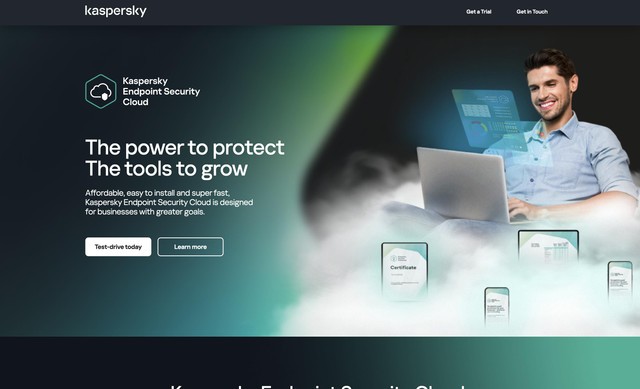
Kaspersky Endpoint Security Cloud is a cybersecurity solution tailored for small to medium-sized businesses. It offers easy installation, fast protection, and cloud-based management, ensuring devices are secure from anywhere. With features like malware protection, ransomware prevention, and cybersecurity training, it aims to provide comprehensive and affordable security.
Kaspersky Endpoint Security Cloud Pricing
Kaspersky Endpoint Security Cloud's pricing is not public. Contact their support for more info.
Kaspersky Endpoint Security Cloud Reviews
Kaspersky Endpoint Security Cloud has an overall rating of 4.3 out of 5 stars based on 217 reviews. Users appreciate its robust protection but note some performance issues. Check out more of our reviews here!
Pros and Cons ofKaspersky Endpoint Security Cloud
Pros:
Ease of Use: Simple installation and management through a web browser, requiring minimal time each week.
Comprehensive Protection: Guards against known and advanced malware threats, including ransomware prevention and malicious activity roll-back.
Cloud Management: No need for additional hardware infrastructure, as everything is managed in the cloud.
Cons:
High Resource Usage: Some users report that the software can be resource-intensive, affecting system performance.
Compatibility Issues: There can be occasional compatibility problems with certain systems and software.
Complex Console Management: The management console may be overwhelming for small businesses without dedicated IT staff.
3. Avast Endpoint Protection

Avast Endpoint Protection is a cybersecurity solution designed to safeguard businesses from various online threats. It offers comprehensive protection, including antivirus, ransomware defense, and secure browsing. With easy deployment and management, Avast aims to provide robust security for businesses of all sizes.
Avast Endpoint Protection Pricing
Avast Essential Business Security: $148.36/year, $29.67 per device per year
Avast Premium Business Security: $187.00/year, $37.40 per device per year
Avast Ultimate Business Security: $227.08/year, $45.42 per device per year
Avast Endpoint Protection Reviews
Avast Endpoint Protection has an overall rating of 4.4 out of 5 stars based on 101 reviews. Users appreciate its rich security features and user-friendly controls. Check out more of our reviews here!
Pros and Cons of Avast Endpoint Protection
Pros:
Comprehensive Protection: Offers antivirus, VPN, and cleanup tools, ensuring all-around security for your devices.
Easy to Use: User-friendly interface and straightforward installation make it accessible for non-tech-savvy users.
Real-time Threat Detection: Continuously monitors and blocks malware, phishing, and other online threats.
Cons:
Performance Impact: Can slow down system performance, particularly on older devices.
False Positives: Occasionally flags legitimate software as malicious, causing unnecessary alerts.
Subscription Costs: Advanced features and comprehensive protection require a paid subscription.
4. Webroot Business Endpoint Protection

Webroot Business Endpoint Protection is a cybersecurity solution designed to protect businesses from various online threats. It offers multi-vector protection, cloud-based management, and advanced machine learning for real-time threat detection. With easy deployment and minimal system impact, Webroot aims to provide robust security for businesses of all sizes.
Webroot Business Endpoint Protection Pricing
Webroot Business Endpoint Protection's pricing is not public. Contact their support for more info.
Webroot Business Endpoint Protection Reviews
Webroot Business Endpoint Protection has an overall rating of 4.6 out of 5 stars based on 524 reviews. Users appreciate its ease of use and integration capabilities. Check out more of our reviews here!
Pros and Cons of Webroot Business Endpoint Protection
Pros:
Multi-Vector Protection: Safeguards against malicious files, scripts, exploits, and URLs, ensuring comprehensive security.
Remote Management: Allows for remote policy definition and management, simplifying administrative tasks.
Minimal System Impact: Nimble agent ensures minimal performance impact, maintaining system efficiency.
Cons:
Agent Issues: Some users report problems with the agent, affecting overall performance.
Compatibility Problems: Occasional issues with integration into existing security infrastructure.
Difficult Navigation: Users find the interface challenging to navigate, complicating management tasks.
5. Cisco Secure Endpoint

Cisco Secure Endpoint is a cloud-native solution designed to enhance endpoint security. It focuses on quick detection, response, and recovery from attacks, reducing remediation times significantly. With features like powerful EDR capabilities and integrated XDR, it aims to provide comprehensive protection for businesses of all sizes.
Cisco Secure Endpoint Pricing
Cisco Secure Endpoint's pricing is not public. Contact their support for more info.
Cisco Secure Endpoint Reviews
Cisco Secure Endpoint has an overall rating of 4.5 out of 5 stars based on 21 reviews. Users praise its ease of use and integration capabilities. Check out more of our reviews here!
Pros and Cons of Cisco Secure Endpoint
Pros:
Powerful EDR Capabilities: Advanced endpoint detection and response, threat hunting, and risk-based vulnerability management.
Streamlined Investigations: Orbital Advanced Search provides quick answers about endpoints, simplifying investigations.
Integrated XDR Capabilities: Unified view and automated playbooks with SecureX platform for efficient incident management.
Cons:
Complexity: Advanced features may be challenging for users to manage without significant expertise.
Cost: High-end security solutions can be expensive, potentially limiting accessibility for smaller organizations.
Learning Curve: Significant training required to effectively utilize advanced capabilities and features.
6. Carbon Black
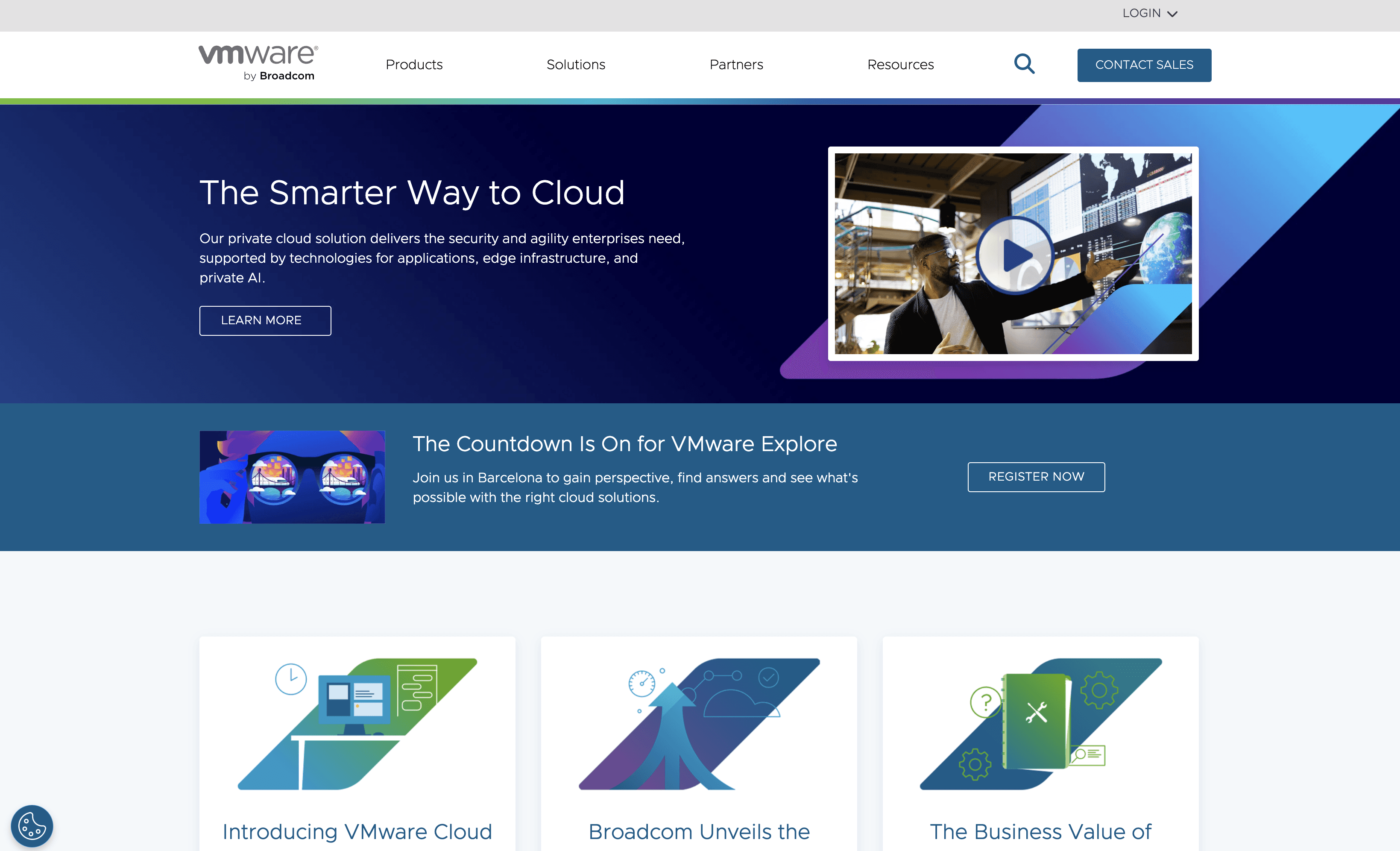
Carbon Black is a cybersecurity solution designed to protect businesses from advanced threats. It offers endpoint detection and response, threat hunting, and real-time visibility. With a focus on ease of use and scalability, Carbon Black aims to provide robust security for organizations of all sizes.
Carbon Black Pricing
Carbon Black's pricing is not public. Contact their support for more info.
Carbon Black Reviews
Carbon Black has an overall rating of 4.3 out of 5 stars based on 37 reviews. Users appreciate its robust protection and ease of use. Check out more of our reviews here!
Pros and Cons of Carbon Black
Pros:
Advanced Threat Detection: Carbon Black excels in identifying and mitigating sophisticated cyber threats, providing robust protection for your business.
Real-Time Monitoring: Continuous monitoring ensures immediate detection and response to potential security breaches, enhancing overall security posture.
Scalability: Designed to grow with your business, Carbon Black offers scalable solutions that adapt to increasing security needs.
Cons:
Complex Setup: Initial installation and configuration can be challenging, requiring significant time and expertise.
Resource Intensive: The software can be demanding on system resources, potentially affecting performance on older devices.
False Positives: Occasional false alerts may lead to unnecessary administrative overhead, complicating threat management.
7. NinjaOne
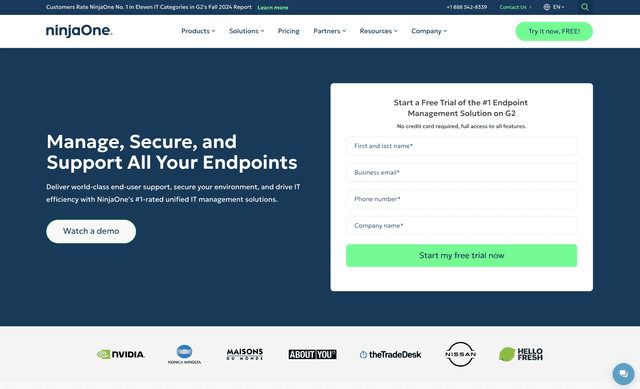
NinjaOne is a unified IT management solution designed to help IT teams manage, secure, and support endpoints. It offers market-leading endpoint visibility and control, enabling IT teams to monitor, manage, patch, and support any endpoint anywhere. The platform is quick to implement, easy to learn, and intuitive to use.
NinjaOne Pricing
NinjaOne's pricing is not public. Contact their support for more info.
NinjaOne Reviews
NinjaOne has an overall rating of 4.8 out of 5 stars based on 1,437 reviews. Users appreciate its ease of use and comprehensive features. Check out more of our reviews here!
Pros and Cons of NinjaOne
Pros:
Comprehensive Endpoint Management: Provides market-leading visibility and control over endpoints, ensuring efficient management and security.
Ease of Use: Quick to implement, easy to learn, and intuitive to use, making it accessible for all IT teams.
Automation: Robust built-in automation workflows improve IT team efficiency, reducing manual tasks and errors.
Cons:
Hidden Costs: Potential hidden costs related to advanced features or integrations not explicitly mentioned, which can affect budgeting.
Complexity for Small Teams: The comprehensive feature set might be overwhelming for smaller IT teams or businesses with simpler needs.
Dependency on Internet: As a cloud-based solution, it requires a reliable internet connection for optimal performance, which can be a limitation.
8. Crowdstrike

CrowdStrike is a cybersecurity solution designed to prevent breaches using AI-native technology. It offers comprehensive protection for endpoints, cloud environments, and identities. With a focus on ease of use and scalability, CrowdStrike aims to provide robust security for businesses of all sizes.
Crowdstrike Pricing
Falcon Pro (Enterprise): $99.99/device per year
Falcon Enterprise: $184.99/device per year
Falcon Elite: Contact sales for pricing
Falcon Flex: Contact us for more information
Falcon Go (Small Business): $59.99/device per year
Falcon Pro (Small Business): $99.99/device per year
Falcon Complete MDR: Contact sales for pricing
Crowdstrike Reviews
CrowdStrike has an overall rating of 4.7 out of 5 stars based on 278 reviews. Users appreciate its effectiveness and ease of use. Check out more of our reviews here!
Pros and Cons of Crowdstrike
Pros:
AI-native Platform: CrowdStrike leverages AI to enhance cybersecurity measures, providing real-time protection and advanced threat detection.
Comprehensive Solutions: Offers a wide range of services including endpoint security, cloud security, identity protection, and more.
Industry Recognition: Consistently recognized as a leader by third-party organizations like Gartner, Forrester, and IDC.
Cons:
Cost: The mention of "Burdensome operations drive up TCO" in the comparison with Microsoft Defender suggests that CrowdStrike's solutions might be more expensive.
Complexity: The need for extensive training and preparation services indicates that the platform might be complex to implement and manage without expert assistance.
Deployment Challenges: Comparisons with competitors like Palo Alto Networks highlight potential difficulties in deployment and management.
9. Absolute Secure Endpoint
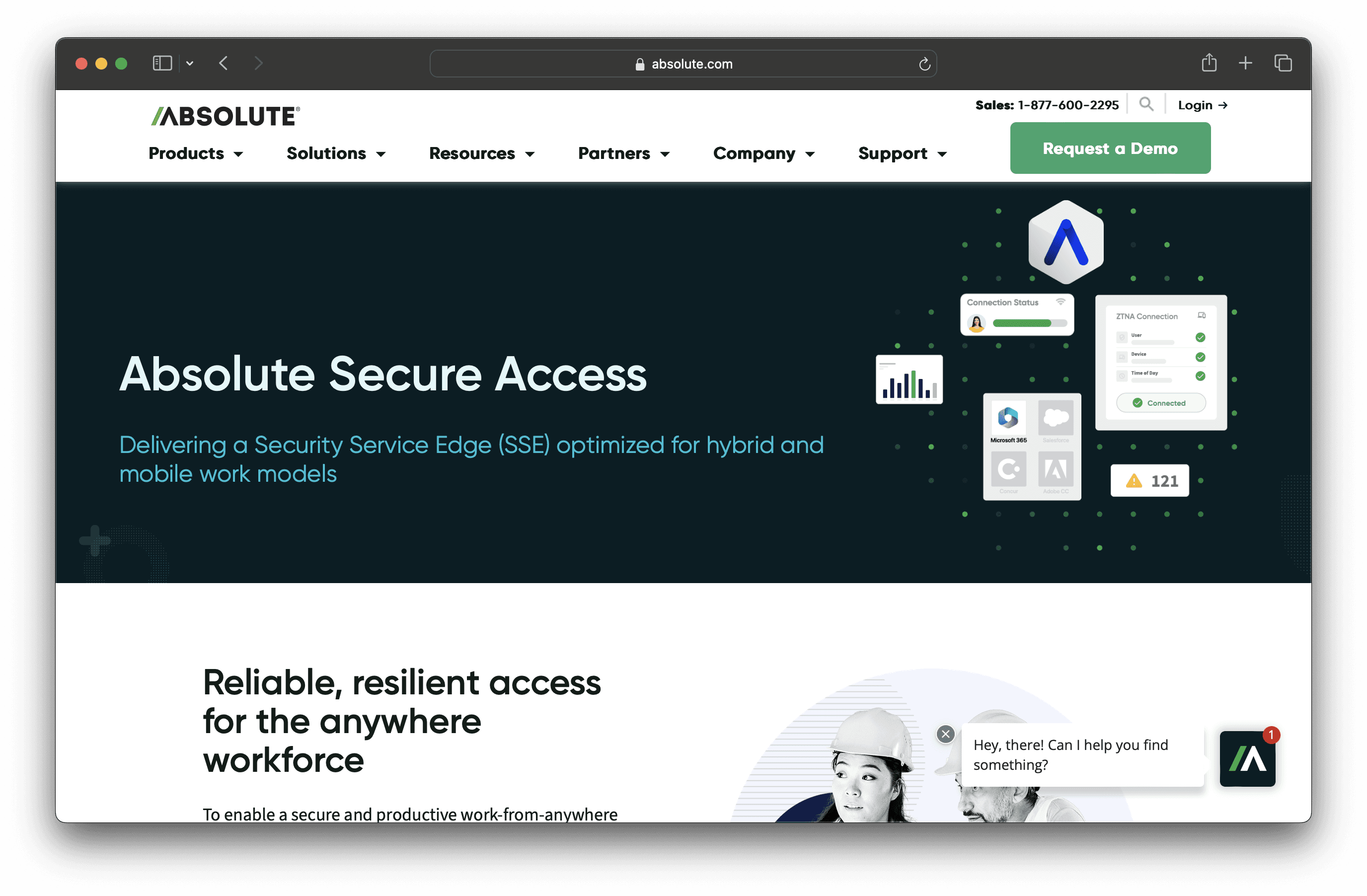
Absolute Secure Endpoint is a cybersecurity solution designed to protect devices and data with features like device tracking, security posture assessment, and application self-healing. It aims to provide comprehensive protection and easy management for businesses of all sizes, ensuring robust security and operational efficiency.
Absolute Secure Endpoint Pricing
Absolute Visibility
Absolute Control
Absolute Resilience
Absolute Secure Endpoint's pricing is not public. Contact their support for more info.
Absolute Secure Endpoint Reviews
Absolute Secure Endpoint has an overall rating of 4.6 out of 5 stars based on 307 reviews. Users appreciate its ease of use and robust tracking capabilities. Check out more of our reviews here!
Pros and Cons of Absolute Secure Endpoint
Pros:
Comprehensive Device Tracking: Tracks hardware and software, providing detailed reports and alerts for better asset management.
Application Self-Healing: Automatically repairs mission-critical applications, ensuring continuous operation and reducing downtime.
Ease of Use: User-friendly interface simplifies device management, making it accessible even for non-technical users.
Cons:
Compatibility Issues: Some features are limited to specific operating systems, restricting full functionality across all devices.
Limited Features: Advanced features are only available in higher-tier packages, potentially increasing costs.
Slow Performance: Users report occasional slowdowns, particularly during intensive security scans.
10. Threatlocker
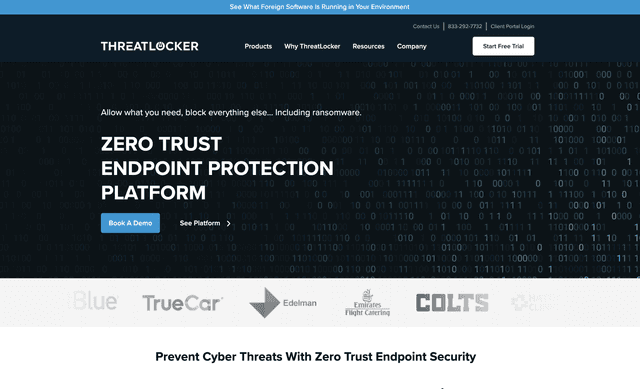
ThreatLocker is a cybersecurity solution designed to provide Zero Trust Endpoint Protection. It focuses on allowing only necessary software to run while blocking everything else, including ransomware. With features like allowlisting, ringfencing, and network control, ThreatLocker aims to offer robust security for businesses of all sizes.
Threatlocker Pricing
Threatlocker's pricing is not public. Contact their support for more info.
Threatlocker Reviews
ThreatLocker has an overall rating of 4.8 out of 5 stars based on 162 reviews. Users appreciate its granular control and excellent customer support. Check out more of our reviews here!
Pros and Cons of Threatlocker
Pros:
Zero Trust Security: Only necessary software runs, blocking everything else, including ransomware, ensuring robust protection.
Comprehensive Suite: Tools like Allowlisting, Ringfencing™, and Network Control offer a holistic cybersecurity approach.
24/7 Support: The Cyber Hero Team provides round-the-clock assistance, ensuring quick response times and expert help.
Cons:
Complexity: The platform's comprehensive nature can be overwhelming for smaller organizations or those without dedicated IT teams.
Implementation Time: Initial setup and policy configuration may require significant time and effort, despite the learning mode.
Cost: Advanced features and 24/7 support might come at a higher cost, potentially limiting accessibility for smaller businesses.
Looking to secure your technical infrastructure?
Twingate offers granular access controls and deployment automations to protect your VPC environment. By leveraging Zero Trust security tools, Twingate ensures that private resources and internet traffic remain secure in the modern world of work. Try Twingate for Free today!
Rapidly implement a modern Zero Trust network that is more secure and maintainable than VPNs.
The Best 10 Alternatives to Hexnode UEM (+ Pricing & Reviews)
Twingate Team
•
Jul 27, 2024

Hexnode UEM is a platform designed to manage various devices and operating systems within an organization, offering a unified solution for endpoint management. While it provides comprehensive features, it might not be the choice for everyone. This article explores the benefits of using Twingate for secure access to private resources.

10 Alternatives to Hexnode UEM
1. WatchGuard Endpoint Security

WatchGuard Endpoint Security is a comprehensive solution designed to combat advanced cyber threats. It integrates various security measures like Endpoint Detection & Response, next-gen antivirus, and DNS-level protection. With centralized management through WatchGuard Cloud, it offers ease of use and robust protection for diverse devices and operating systems.
WatchGuard Endpoint Security Pricing
WatchGuard Endpoint Security's pricing is not public. Contact their support for more info.
WatchGuard Endpoint Security Reviews
WatchGuard Endpoint Security has an overall rating of 4.4 out of 5 stars based on 115 reviews. Users praise its comprehensive protection and ease of use. Check out more of our reviews here!
Pros and Cons of WatchGuard Endpoint Security
Pros:
Comprehensive protection against advanced threats, including fileless malware, APTs, and ransomware, ensuring robust security for diverse environments.
Cloud-native security solution supports multiple operating systems and devices, offering flexibility and scalability for growing organizations.
Centralized management through WatchGuard Cloud simplifies administration and enhances visibility, making it easier to monitor and respond to threats.
Cons:
Compatibility issues with certain systems can lead to operational disruptions, requiring additional troubleshooting and support.
False positives may occur, potentially causing unnecessary alerts and administrative overhead to resolve these inaccuracies.
Installation difficulties reported by some users, indicating a need for improved setup processes or more comprehensive installation guides.
2. Kaspersky Endpoint Security Cloud

Kaspersky Endpoint Security Cloud is a cybersecurity solution tailored for small to medium-sized businesses. It offers easy installation, fast protection, and cloud-based management, ensuring devices are secure from anywhere. With features like malware protection, ransomware prevention, and cybersecurity training, it aims to provide comprehensive and affordable security.
Kaspersky Endpoint Security Cloud Pricing
Kaspersky Endpoint Security Cloud's pricing is not public. Contact their support for more info.
Kaspersky Endpoint Security Cloud Reviews
Kaspersky Endpoint Security Cloud has an overall rating of 4.3 out of 5 stars based on 217 reviews. Users appreciate its robust protection but note some performance issues. Check out more of our reviews here!
Pros and Cons ofKaspersky Endpoint Security Cloud
Pros:
Ease of Use: Simple installation and management through a web browser, requiring minimal time each week.
Comprehensive Protection: Guards against known and advanced malware threats, including ransomware prevention and malicious activity roll-back.
Cloud Management: No need for additional hardware infrastructure, as everything is managed in the cloud.
Cons:
High Resource Usage: Some users report that the software can be resource-intensive, affecting system performance.
Compatibility Issues: There can be occasional compatibility problems with certain systems and software.
Complex Console Management: The management console may be overwhelming for small businesses without dedicated IT staff.
3. Avast Endpoint Protection

Avast Endpoint Protection is a cybersecurity solution designed to safeguard businesses from various online threats. It offers comprehensive protection, including antivirus, ransomware defense, and secure browsing. With easy deployment and management, Avast aims to provide robust security for businesses of all sizes.
Avast Endpoint Protection Pricing
Avast Essential Business Security: $148.36/year, $29.67 per device per year
Avast Premium Business Security: $187.00/year, $37.40 per device per year
Avast Ultimate Business Security: $227.08/year, $45.42 per device per year
Avast Endpoint Protection Reviews
Avast Endpoint Protection has an overall rating of 4.4 out of 5 stars based on 101 reviews. Users appreciate its rich security features and user-friendly controls. Check out more of our reviews here!
Pros and Cons of Avast Endpoint Protection
Pros:
Comprehensive Protection: Offers antivirus, VPN, and cleanup tools, ensuring all-around security for your devices.
Easy to Use: User-friendly interface and straightforward installation make it accessible for non-tech-savvy users.
Real-time Threat Detection: Continuously monitors and blocks malware, phishing, and other online threats.
Cons:
Performance Impact: Can slow down system performance, particularly on older devices.
False Positives: Occasionally flags legitimate software as malicious, causing unnecessary alerts.
Subscription Costs: Advanced features and comprehensive protection require a paid subscription.
4. Webroot Business Endpoint Protection

Webroot Business Endpoint Protection is a cybersecurity solution designed to protect businesses from various online threats. It offers multi-vector protection, cloud-based management, and advanced machine learning for real-time threat detection. With easy deployment and minimal system impact, Webroot aims to provide robust security for businesses of all sizes.
Webroot Business Endpoint Protection Pricing
Webroot Business Endpoint Protection's pricing is not public. Contact their support for more info.
Webroot Business Endpoint Protection Reviews
Webroot Business Endpoint Protection has an overall rating of 4.6 out of 5 stars based on 524 reviews. Users appreciate its ease of use and integration capabilities. Check out more of our reviews here!
Pros and Cons of Webroot Business Endpoint Protection
Pros:
Multi-Vector Protection: Safeguards against malicious files, scripts, exploits, and URLs, ensuring comprehensive security.
Remote Management: Allows for remote policy definition and management, simplifying administrative tasks.
Minimal System Impact: Nimble agent ensures minimal performance impact, maintaining system efficiency.
Cons:
Agent Issues: Some users report problems with the agent, affecting overall performance.
Compatibility Problems: Occasional issues with integration into existing security infrastructure.
Difficult Navigation: Users find the interface challenging to navigate, complicating management tasks.
5. Cisco Secure Endpoint

Cisco Secure Endpoint is a cloud-native solution designed to enhance endpoint security. It focuses on quick detection, response, and recovery from attacks, reducing remediation times significantly. With features like powerful EDR capabilities and integrated XDR, it aims to provide comprehensive protection for businesses of all sizes.
Cisco Secure Endpoint Pricing
Cisco Secure Endpoint's pricing is not public. Contact their support for more info.
Cisco Secure Endpoint Reviews
Cisco Secure Endpoint has an overall rating of 4.5 out of 5 stars based on 21 reviews. Users praise its ease of use and integration capabilities. Check out more of our reviews here!
Pros and Cons of Cisco Secure Endpoint
Pros:
Powerful EDR Capabilities: Advanced endpoint detection and response, threat hunting, and risk-based vulnerability management.
Streamlined Investigations: Orbital Advanced Search provides quick answers about endpoints, simplifying investigations.
Integrated XDR Capabilities: Unified view and automated playbooks with SecureX platform for efficient incident management.
Cons:
Complexity: Advanced features may be challenging for users to manage without significant expertise.
Cost: High-end security solutions can be expensive, potentially limiting accessibility for smaller organizations.
Learning Curve: Significant training required to effectively utilize advanced capabilities and features.
6. Carbon Black

Carbon Black is a cybersecurity solution designed to protect businesses from advanced threats. It offers endpoint detection and response, threat hunting, and real-time visibility. With a focus on ease of use and scalability, Carbon Black aims to provide robust security for organizations of all sizes.
Carbon Black Pricing
Carbon Black's pricing is not public. Contact their support for more info.
Carbon Black Reviews
Carbon Black has an overall rating of 4.3 out of 5 stars based on 37 reviews. Users appreciate its robust protection and ease of use. Check out more of our reviews here!
Pros and Cons of Carbon Black
Pros:
Advanced Threat Detection: Carbon Black excels in identifying and mitigating sophisticated cyber threats, providing robust protection for your business.
Real-Time Monitoring: Continuous monitoring ensures immediate detection and response to potential security breaches, enhancing overall security posture.
Scalability: Designed to grow with your business, Carbon Black offers scalable solutions that adapt to increasing security needs.
Cons:
Complex Setup: Initial installation and configuration can be challenging, requiring significant time and expertise.
Resource Intensive: The software can be demanding on system resources, potentially affecting performance on older devices.
False Positives: Occasional false alerts may lead to unnecessary administrative overhead, complicating threat management.
7. NinjaOne

NinjaOne is a unified IT management solution designed to help IT teams manage, secure, and support endpoints. It offers market-leading endpoint visibility and control, enabling IT teams to monitor, manage, patch, and support any endpoint anywhere. The platform is quick to implement, easy to learn, and intuitive to use.
NinjaOne Pricing
NinjaOne's pricing is not public. Contact their support for more info.
NinjaOne Reviews
NinjaOne has an overall rating of 4.8 out of 5 stars based on 1,437 reviews. Users appreciate its ease of use and comprehensive features. Check out more of our reviews here!
Pros and Cons of NinjaOne
Pros:
Comprehensive Endpoint Management: Provides market-leading visibility and control over endpoints, ensuring efficient management and security.
Ease of Use: Quick to implement, easy to learn, and intuitive to use, making it accessible for all IT teams.
Automation: Robust built-in automation workflows improve IT team efficiency, reducing manual tasks and errors.
Cons:
Hidden Costs: Potential hidden costs related to advanced features or integrations not explicitly mentioned, which can affect budgeting.
Complexity for Small Teams: The comprehensive feature set might be overwhelming for smaller IT teams or businesses with simpler needs.
Dependency on Internet: As a cloud-based solution, it requires a reliable internet connection for optimal performance, which can be a limitation.
8. Crowdstrike

CrowdStrike is a cybersecurity solution designed to prevent breaches using AI-native technology. It offers comprehensive protection for endpoints, cloud environments, and identities. With a focus on ease of use and scalability, CrowdStrike aims to provide robust security for businesses of all sizes.
Crowdstrike Pricing
Falcon Pro (Enterprise): $99.99/device per year
Falcon Enterprise: $184.99/device per year
Falcon Elite: Contact sales for pricing
Falcon Flex: Contact us for more information
Falcon Go (Small Business): $59.99/device per year
Falcon Pro (Small Business): $99.99/device per year
Falcon Complete MDR: Contact sales for pricing
Crowdstrike Reviews
CrowdStrike has an overall rating of 4.7 out of 5 stars based on 278 reviews. Users appreciate its effectiveness and ease of use. Check out more of our reviews here!
Pros and Cons of Crowdstrike
Pros:
AI-native Platform: CrowdStrike leverages AI to enhance cybersecurity measures, providing real-time protection and advanced threat detection.
Comprehensive Solutions: Offers a wide range of services including endpoint security, cloud security, identity protection, and more.
Industry Recognition: Consistently recognized as a leader by third-party organizations like Gartner, Forrester, and IDC.
Cons:
Cost: The mention of "Burdensome operations drive up TCO" in the comparison with Microsoft Defender suggests that CrowdStrike's solutions might be more expensive.
Complexity: The need for extensive training and preparation services indicates that the platform might be complex to implement and manage without expert assistance.
Deployment Challenges: Comparisons with competitors like Palo Alto Networks highlight potential difficulties in deployment and management.
9. Absolute Secure Endpoint

Absolute Secure Endpoint is a cybersecurity solution designed to protect devices and data with features like device tracking, security posture assessment, and application self-healing. It aims to provide comprehensive protection and easy management for businesses of all sizes, ensuring robust security and operational efficiency.
Absolute Secure Endpoint Pricing
Absolute Visibility
Absolute Control
Absolute Resilience
Absolute Secure Endpoint's pricing is not public. Contact their support for more info.
Absolute Secure Endpoint Reviews
Absolute Secure Endpoint has an overall rating of 4.6 out of 5 stars based on 307 reviews. Users appreciate its ease of use and robust tracking capabilities. Check out more of our reviews here!
Pros and Cons of Absolute Secure Endpoint
Pros:
Comprehensive Device Tracking: Tracks hardware and software, providing detailed reports and alerts for better asset management.
Application Self-Healing: Automatically repairs mission-critical applications, ensuring continuous operation and reducing downtime.
Ease of Use: User-friendly interface simplifies device management, making it accessible even for non-technical users.
Cons:
Compatibility Issues: Some features are limited to specific operating systems, restricting full functionality across all devices.
Limited Features: Advanced features are only available in higher-tier packages, potentially increasing costs.
Slow Performance: Users report occasional slowdowns, particularly during intensive security scans.
10. Threatlocker

ThreatLocker is a cybersecurity solution designed to provide Zero Trust Endpoint Protection. It focuses on allowing only necessary software to run while blocking everything else, including ransomware. With features like allowlisting, ringfencing, and network control, ThreatLocker aims to offer robust security for businesses of all sizes.
Threatlocker Pricing
Threatlocker's pricing is not public. Contact their support for more info.
Threatlocker Reviews
ThreatLocker has an overall rating of 4.8 out of 5 stars based on 162 reviews. Users appreciate its granular control and excellent customer support. Check out more of our reviews here!
Pros and Cons of Threatlocker
Pros:
Zero Trust Security: Only necessary software runs, blocking everything else, including ransomware, ensuring robust protection.
Comprehensive Suite: Tools like Allowlisting, Ringfencing™, and Network Control offer a holistic cybersecurity approach.
24/7 Support: The Cyber Hero Team provides round-the-clock assistance, ensuring quick response times and expert help.
Cons:
Complexity: The platform's comprehensive nature can be overwhelming for smaller organizations or those without dedicated IT teams.
Implementation Time: Initial setup and policy configuration may require significant time and effort, despite the learning mode.
Cost: Advanced features and 24/7 support might come at a higher cost, potentially limiting accessibility for smaller businesses.
Looking to secure your technical infrastructure?
Twingate offers granular access controls and deployment automations to protect your VPC environment. By leveraging Zero Trust security tools, Twingate ensures that private resources and internet traffic remain secure in the modern world of work. Try Twingate for Free today!
Rapidly implement a modern Zero Trust network that is more secure and maintainable than VPNs.
The Best 10 Alternatives to Hexnode UEM (+ Pricing & Reviews)
Twingate Team
•
Jul 27, 2024

Hexnode UEM is a platform designed to manage various devices and operating systems within an organization, offering a unified solution for endpoint management. While it provides comprehensive features, it might not be the choice for everyone. This article explores the benefits of using Twingate for secure access to private resources.

10 Alternatives to Hexnode UEM
1. WatchGuard Endpoint Security

WatchGuard Endpoint Security is a comprehensive solution designed to combat advanced cyber threats. It integrates various security measures like Endpoint Detection & Response, next-gen antivirus, and DNS-level protection. With centralized management through WatchGuard Cloud, it offers ease of use and robust protection for diverse devices and operating systems.
WatchGuard Endpoint Security Pricing
WatchGuard Endpoint Security's pricing is not public. Contact their support for more info.
WatchGuard Endpoint Security Reviews
WatchGuard Endpoint Security has an overall rating of 4.4 out of 5 stars based on 115 reviews. Users praise its comprehensive protection and ease of use. Check out more of our reviews here!
Pros and Cons of WatchGuard Endpoint Security
Pros:
Comprehensive protection against advanced threats, including fileless malware, APTs, and ransomware, ensuring robust security for diverse environments.
Cloud-native security solution supports multiple operating systems and devices, offering flexibility and scalability for growing organizations.
Centralized management through WatchGuard Cloud simplifies administration and enhances visibility, making it easier to monitor and respond to threats.
Cons:
Compatibility issues with certain systems can lead to operational disruptions, requiring additional troubleshooting and support.
False positives may occur, potentially causing unnecessary alerts and administrative overhead to resolve these inaccuracies.
Installation difficulties reported by some users, indicating a need for improved setup processes or more comprehensive installation guides.
2. Kaspersky Endpoint Security Cloud

Kaspersky Endpoint Security Cloud is a cybersecurity solution tailored for small to medium-sized businesses. It offers easy installation, fast protection, and cloud-based management, ensuring devices are secure from anywhere. With features like malware protection, ransomware prevention, and cybersecurity training, it aims to provide comprehensive and affordable security.
Kaspersky Endpoint Security Cloud Pricing
Kaspersky Endpoint Security Cloud's pricing is not public. Contact their support for more info.
Kaspersky Endpoint Security Cloud Reviews
Kaspersky Endpoint Security Cloud has an overall rating of 4.3 out of 5 stars based on 217 reviews. Users appreciate its robust protection but note some performance issues. Check out more of our reviews here!
Pros and Cons ofKaspersky Endpoint Security Cloud
Pros:
Ease of Use: Simple installation and management through a web browser, requiring minimal time each week.
Comprehensive Protection: Guards against known and advanced malware threats, including ransomware prevention and malicious activity roll-back.
Cloud Management: No need for additional hardware infrastructure, as everything is managed in the cloud.
Cons:
High Resource Usage: Some users report that the software can be resource-intensive, affecting system performance.
Compatibility Issues: There can be occasional compatibility problems with certain systems and software.
Complex Console Management: The management console may be overwhelming for small businesses without dedicated IT staff.
3. Avast Endpoint Protection

Avast Endpoint Protection is a cybersecurity solution designed to safeguard businesses from various online threats. It offers comprehensive protection, including antivirus, ransomware defense, and secure browsing. With easy deployment and management, Avast aims to provide robust security for businesses of all sizes.
Avast Endpoint Protection Pricing
Avast Essential Business Security: $148.36/year, $29.67 per device per year
Avast Premium Business Security: $187.00/year, $37.40 per device per year
Avast Ultimate Business Security: $227.08/year, $45.42 per device per year
Avast Endpoint Protection Reviews
Avast Endpoint Protection has an overall rating of 4.4 out of 5 stars based on 101 reviews. Users appreciate its rich security features and user-friendly controls. Check out more of our reviews here!
Pros and Cons of Avast Endpoint Protection
Pros:
Comprehensive Protection: Offers antivirus, VPN, and cleanup tools, ensuring all-around security for your devices.
Easy to Use: User-friendly interface and straightforward installation make it accessible for non-tech-savvy users.
Real-time Threat Detection: Continuously monitors and blocks malware, phishing, and other online threats.
Cons:
Performance Impact: Can slow down system performance, particularly on older devices.
False Positives: Occasionally flags legitimate software as malicious, causing unnecessary alerts.
Subscription Costs: Advanced features and comprehensive protection require a paid subscription.
4. Webroot Business Endpoint Protection

Webroot Business Endpoint Protection is a cybersecurity solution designed to protect businesses from various online threats. It offers multi-vector protection, cloud-based management, and advanced machine learning for real-time threat detection. With easy deployment and minimal system impact, Webroot aims to provide robust security for businesses of all sizes.
Webroot Business Endpoint Protection Pricing
Webroot Business Endpoint Protection's pricing is not public. Contact their support for more info.
Webroot Business Endpoint Protection Reviews
Webroot Business Endpoint Protection has an overall rating of 4.6 out of 5 stars based on 524 reviews. Users appreciate its ease of use and integration capabilities. Check out more of our reviews here!
Pros and Cons of Webroot Business Endpoint Protection
Pros:
Multi-Vector Protection: Safeguards against malicious files, scripts, exploits, and URLs, ensuring comprehensive security.
Remote Management: Allows for remote policy definition and management, simplifying administrative tasks.
Minimal System Impact: Nimble agent ensures minimal performance impact, maintaining system efficiency.
Cons:
Agent Issues: Some users report problems with the agent, affecting overall performance.
Compatibility Problems: Occasional issues with integration into existing security infrastructure.
Difficult Navigation: Users find the interface challenging to navigate, complicating management tasks.
5. Cisco Secure Endpoint

Cisco Secure Endpoint is a cloud-native solution designed to enhance endpoint security. It focuses on quick detection, response, and recovery from attacks, reducing remediation times significantly. With features like powerful EDR capabilities and integrated XDR, it aims to provide comprehensive protection for businesses of all sizes.
Cisco Secure Endpoint Pricing
Cisco Secure Endpoint's pricing is not public. Contact their support for more info.
Cisco Secure Endpoint Reviews
Cisco Secure Endpoint has an overall rating of 4.5 out of 5 stars based on 21 reviews. Users praise its ease of use and integration capabilities. Check out more of our reviews here!
Pros and Cons of Cisco Secure Endpoint
Pros:
Powerful EDR Capabilities: Advanced endpoint detection and response, threat hunting, and risk-based vulnerability management.
Streamlined Investigations: Orbital Advanced Search provides quick answers about endpoints, simplifying investigations.
Integrated XDR Capabilities: Unified view and automated playbooks with SecureX platform for efficient incident management.
Cons:
Complexity: Advanced features may be challenging for users to manage without significant expertise.
Cost: High-end security solutions can be expensive, potentially limiting accessibility for smaller organizations.
Learning Curve: Significant training required to effectively utilize advanced capabilities and features.
6. Carbon Black

Carbon Black is a cybersecurity solution designed to protect businesses from advanced threats. It offers endpoint detection and response, threat hunting, and real-time visibility. With a focus on ease of use and scalability, Carbon Black aims to provide robust security for organizations of all sizes.
Carbon Black Pricing
Carbon Black's pricing is not public. Contact their support for more info.
Carbon Black Reviews
Carbon Black has an overall rating of 4.3 out of 5 stars based on 37 reviews. Users appreciate its robust protection and ease of use. Check out more of our reviews here!
Pros and Cons of Carbon Black
Pros:
Advanced Threat Detection: Carbon Black excels in identifying and mitigating sophisticated cyber threats, providing robust protection for your business.
Real-Time Monitoring: Continuous monitoring ensures immediate detection and response to potential security breaches, enhancing overall security posture.
Scalability: Designed to grow with your business, Carbon Black offers scalable solutions that adapt to increasing security needs.
Cons:
Complex Setup: Initial installation and configuration can be challenging, requiring significant time and expertise.
Resource Intensive: The software can be demanding on system resources, potentially affecting performance on older devices.
False Positives: Occasional false alerts may lead to unnecessary administrative overhead, complicating threat management.
7. NinjaOne

NinjaOne is a unified IT management solution designed to help IT teams manage, secure, and support endpoints. It offers market-leading endpoint visibility and control, enabling IT teams to monitor, manage, patch, and support any endpoint anywhere. The platform is quick to implement, easy to learn, and intuitive to use.
NinjaOne Pricing
NinjaOne's pricing is not public. Contact their support for more info.
NinjaOne Reviews
NinjaOne has an overall rating of 4.8 out of 5 stars based on 1,437 reviews. Users appreciate its ease of use and comprehensive features. Check out more of our reviews here!
Pros and Cons of NinjaOne
Pros:
Comprehensive Endpoint Management: Provides market-leading visibility and control over endpoints, ensuring efficient management and security.
Ease of Use: Quick to implement, easy to learn, and intuitive to use, making it accessible for all IT teams.
Automation: Robust built-in automation workflows improve IT team efficiency, reducing manual tasks and errors.
Cons:
Hidden Costs: Potential hidden costs related to advanced features or integrations not explicitly mentioned, which can affect budgeting.
Complexity for Small Teams: The comprehensive feature set might be overwhelming for smaller IT teams or businesses with simpler needs.
Dependency on Internet: As a cloud-based solution, it requires a reliable internet connection for optimal performance, which can be a limitation.
8. Crowdstrike

CrowdStrike is a cybersecurity solution designed to prevent breaches using AI-native technology. It offers comprehensive protection for endpoints, cloud environments, and identities. With a focus on ease of use and scalability, CrowdStrike aims to provide robust security for businesses of all sizes.
Crowdstrike Pricing
Falcon Pro (Enterprise): $99.99/device per year
Falcon Enterprise: $184.99/device per year
Falcon Elite: Contact sales for pricing
Falcon Flex: Contact us for more information
Falcon Go (Small Business): $59.99/device per year
Falcon Pro (Small Business): $99.99/device per year
Falcon Complete MDR: Contact sales for pricing
Crowdstrike Reviews
CrowdStrike has an overall rating of 4.7 out of 5 stars based on 278 reviews. Users appreciate its effectiveness and ease of use. Check out more of our reviews here!
Pros and Cons of Crowdstrike
Pros:
AI-native Platform: CrowdStrike leverages AI to enhance cybersecurity measures, providing real-time protection and advanced threat detection.
Comprehensive Solutions: Offers a wide range of services including endpoint security, cloud security, identity protection, and more.
Industry Recognition: Consistently recognized as a leader by third-party organizations like Gartner, Forrester, and IDC.
Cons:
Cost: The mention of "Burdensome operations drive up TCO" in the comparison with Microsoft Defender suggests that CrowdStrike's solutions might be more expensive.
Complexity: The need for extensive training and preparation services indicates that the platform might be complex to implement and manage without expert assistance.
Deployment Challenges: Comparisons with competitors like Palo Alto Networks highlight potential difficulties in deployment and management.
9. Absolute Secure Endpoint

Absolute Secure Endpoint is a cybersecurity solution designed to protect devices and data with features like device tracking, security posture assessment, and application self-healing. It aims to provide comprehensive protection and easy management for businesses of all sizes, ensuring robust security and operational efficiency.
Absolute Secure Endpoint Pricing
Absolute Visibility
Absolute Control
Absolute Resilience
Absolute Secure Endpoint's pricing is not public. Contact their support for more info.
Absolute Secure Endpoint Reviews
Absolute Secure Endpoint has an overall rating of 4.6 out of 5 stars based on 307 reviews. Users appreciate its ease of use and robust tracking capabilities. Check out more of our reviews here!
Pros and Cons of Absolute Secure Endpoint
Pros:
Comprehensive Device Tracking: Tracks hardware and software, providing detailed reports and alerts for better asset management.
Application Self-Healing: Automatically repairs mission-critical applications, ensuring continuous operation and reducing downtime.
Ease of Use: User-friendly interface simplifies device management, making it accessible even for non-technical users.
Cons:
Compatibility Issues: Some features are limited to specific operating systems, restricting full functionality across all devices.
Limited Features: Advanced features are only available in higher-tier packages, potentially increasing costs.
Slow Performance: Users report occasional slowdowns, particularly during intensive security scans.
10. Threatlocker

ThreatLocker is a cybersecurity solution designed to provide Zero Trust Endpoint Protection. It focuses on allowing only necessary software to run while blocking everything else, including ransomware. With features like allowlisting, ringfencing, and network control, ThreatLocker aims to offer robust security for businesses of all sizes.
Threatlocker Pricing
Threatlocker's pricing is not public. Contact their support for more info.
Threatlocker Reviews
ThreatLocker has an overall rating of 4.8 out of 5 stars based on 162 reviews. Users appreciate its granular control and excellent customer support. Check out more of our reviews here!
Pros and Cons of Threatlocker
Pros:
Zero Trust Security: Only necessary software runs, blocking everything else, including ransomware, ensuring robust protection.
Comprehensive Suite: Tools like Allowlisting, Ringfencing™, and Network Control offer a holistic cybersecurity approach.
24/7 Support: The Cyber Hero Team provides round-the-clock assistance, ensuring quick response times and expert help.
Cons:
Complexity: The platform's comprehensive nature can be overwhelming for smaller organizations or those without dedicated IT teams.
Implementation Time: Initial setup and policy configuration may require significant time and effort, despite the learning mode.
Cost: Advanced features and 24/7 support might come at a higher cost, potentially limiting accessibility for smaller businesses.
Looking to secure your technical infrastructure?
Twingate offers granular access controls and deployment automations to protect your VPC environment. By leveraging Zero Trust security tools, Twingate ensures that private resources and internet traffic remain secure in the modern world of work. Try Twingate for Free today!
Solutions
Solutions
The VPN replacement your workforce will love.
Solutions